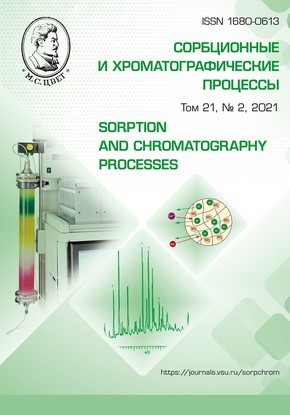Biohydroxyapatite is a new phase for the selective microweighing of organic compound vapours - markers of inflammation in the nasal mucus of calves and hu-mans Report 2. Analysis of real objects
Abstract
In the second part of this article, the possibilities of identifying individual volatile organic compounds of various classes in a mixture of vapours at the level of microconcentrations without separation are considered. Parameters for solving the problems of a qualitative analysis of a mixture of compounds based on signals from sensors with phases of nanostructured biohydroxyapatite (HA) of different masses are proposed and substantiated, both during the injection and frontal introduction of vapours into the detection cell. The efficiency and selectivity of the microweighing of vapours with HA phases has been estimated; it was shown that a high information content of the analysis is characteristic for the simultaneous use of HA of different masses in one array of piezosensors. The synergism of the information content of measuring signals in a mixture was confirmed with the simultaneous use of several sensors of the same type with coatings of the same nature of different masses. An approach for the analysis of the nasal mucus of calves and humans during the development of diseases of the upper respiratory airway is presented. The correctness of the approach was demonstrated based on the example of the analysis of biological samples of the nasal mucus of 50 calves and 17 human volunteers. The numerical values of the identification parameter, calculated from the signals of two sensors with different masses of HA phases on the electrodes of the piezoquartz plate were identified, the reliability of assigning samples to the "inflammation" group, the frequency of errors of the first and second kind in binary classification was estimated. The correctness of data interpretation is based on the results of the analysis of biological samples (laboratory tests), clinical analysis, and the examination of animals by specialists. The results of using the identification parameter of sensors with HA for the classification of biological samples of human nasal mucus confirmed the stability of the parameter and the minimum error rate of false positive classification errors.
Downloads
References
Purkhart R., Köhler H., Liebler-Tenorio E., Meyer M. et al., J. Breath. Res., 2011, Vol. 5, No 2, 027103 DOI: 10.1088/1752-7155/5/2/027103.
Knobloch H., Schroedl W., Turner C. et al., Sens Actuators B Chem., 2010, Vol. 144, No 1, pp. 81-7. https://doi.org/10.1016/j.snb.2009.10.034.
Ostermann C., Schroedl W., Schubert E., Sachse K., et al., Vet. J, 2013, Vol. 196, Vol. 3, pp. 351-359. DOI: 10.1016/j.tvjl.2012.10.035.
Abutarbush S.M., Pollock C.M., Wild-man B.K. et al., Can. J. Vet. Res., 2012, Vol. 76, No 1, pp. 23-32.
McGuirk S.M., Veterinary Clinics of North America: Food Animal Practice. 2008. Vol. 24, pp 139-153. http://dx.doi.org/10.1016/j.cvfa.2007.10.003.
Bulanov E.N., Poluchenie i issledovanie nanostrukturirovannyh biosovmestimyh ma-terialov na osnove gidroksiapatita, Nizhnij Novgorod, 2012, pp. 64-100.
Korenman Ja.I., Silina Ju.E., Kuchmenko T.A. Patent RF, № 2259007, 2004.
Kuchmenko T.A., Shuba A.A., Bel'skih N.V., Analitika i kontrol', 2012, Vol. 16, No 2, pp. 151-161.
Shuba A.A., Kuchmenko T.A., Umarkhanov R.U., Chernitskiy A.E., Allsen-sors, 2020, The Fifth International Confer-ence on Advances in Sensors, Actuators, Metering and Sensing., March 16-22, 2020, Valencia, Spain, 2020, pp 56-62.
Kuchmenko T.A., Shuba A.A., Umar-hanov R.U., Chernickij A.E., Analitika i kontrol', 2019, Vol. 23, No 4, pp. 557-562.







